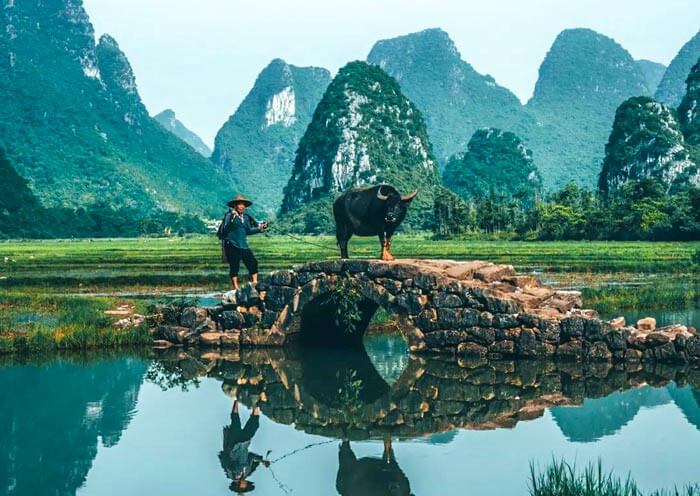Planning to explore China's breathtaking natural wonders? Check out China Nature Travel Tips and Nature Travel FAQs for essential advice. Learn about the best time to visit, transportation options, and must-see highlights.
Explore China's natural wonders with essential tips and FAQs! From breathtaking sites like Zhangjiajie, Jiuzhaigou Valley, and the Rainbow Mountains, to vast deserts and iconic rivers, China offers unparalleled natural beauty.
Whether you're hiking scenic trails or cruising picturesque rivers, knowing these 30+ Things will enhance your experience of China's stunning natural beauty. Check China Nature Travel Tips for advice on the best time to visit, transportation, and must-see highlights!

"Excellent Tour, best experience"
"A unique experience despite a difficult context thanks
to an experience team of organisers"
1. What natural wonders does China have?+
China is home to a wide array of natural wonders, showcasing its diverse landscapes and breathtaking beauty. Here are some of the notable natural wonders found in China:
1). Zhangjiajie National Forest Park: Famous for its towering sandstone pillars, misty mountains, and lush vegetation, Zhangjiajie offers a surreal landscape that inspired the floating mountains in the movie "Avatar."
2). Jiuzhaigou Valley: Known for its vibrant turquoise lakes, cascading waterfalls, and snow-capped peaks, Jiuzhaigou Valley is a UNESCO World Heritage site that captivates visitors with its pristine beauty.
3). Huangshan (Yellow Mountain): Renowned for its unique granite peaks, ancient pine trees, hot springs, and sea of clouds, Huangshan is often considered one of China's most picturesque mountains.
4). The Three Gorges: Located along the Yangtze River, the Three Gorges (Qutang, Wu, and Xiling) are a series of deep and dramatic canyons flanked by towering cliffs. The area is famous for its stunning landscapes and is a popular destination for river cruises.
5). Guilin and Yangshuo: Guilin's karst landscape, characterized by limestone peaks rising from emerald-green waters, is a sight to behold. The Li River meandering through the region, along with the charming countryside of Yangshuo, offers picturesque scenery at every turn.
6). Mount Everest (Mount Qomolangma): As the world's highest peak, Mount Qomolangma is a natural wonder that attracts adventurers and mountaineers from around the globe. Located in Tibet (Xizang), it stands as a symbol of immense beauty and challenge.
7). Tibetan Plateau: The Tibetan Plateau, often referred to as the "Roof of the World," boasts stunning landscapes, including vast grasslands, pristine lakes, and snow-capped mountains.
8). Karst Landscapes: China is renowned for its karst topography, particularly in regions like Guilin, Yangshuo, and Guangxi. These areas are characterized by limestone hills, caves, and underground rivers, creating a unique and captivating natural environment.
9). The Silk Road: The historic Silk Road traverses through diverse landscapes, including deserts, mountains, and oasis towns. Along the route, travelers can encounter natural wonders like the Taklamakan Desert, the Heavenly Lake in Xinjiang, and the colorful Rainbow Mountains in Zhangye.
10). Tiger Leaping Gorge: Tiger Leaping Gorge is a renowned natural wonder located in Yunnan. It is one of the deepest and most spectacular river canyons in the world. Carved by the powerful Jinsha River, which is part of the upper Yangtze River, Tiger Leaping Gorge stretches for about 15 kilometers and boasts dramatic cliffs, roaring rapids, and stunning vistas.
These are just a few examples of the natural wonders that China has to offer. The country's vast and varied geography provides a wealth of breathtaking landscapes, making it an ideal destination for nature enthusiasts and avid explorers.
2. How many World Cultural and Natural Heritage Sites are there in China?+
There are 4 World Cultural and natural Heritage Sites in China. Here is the list of China World Cultural and natural Heritage Sites:
1) . Mount Taishan (1987), Tai'an of Shandong province, China
3. How many World Natural Heritage Sites are there in China?+
There are 10 World Natural Heritage Sites in China. Here is the list of China World Natural Heritage Sites:
1).Jiuzhaigou Valley (1992), Jiuzhaigou County of Sichuan Province, China
2).Huanglong National Park (1992), Songpan County of Sichuan Province, China
3).Sichuan Giant Panda Sanctuaries (2006, Wolong, Mt Siguniang and Jiajin Mountains), Sichuan province, China
4).Wulingyuan (1992), Zhangjiajie of Hunan province, China
5).South China Karst(2007, 2014, Guizhou, Guangxi, Yunnan, Chongqing), China
6).Three Parallel Rivers of Yunnan (2003), Yunnan province, China
7).Chengjiang Fossil Site(2012), Yunnan province, China
8).Xinjiang Tianshan (2013), Xinjiang, China
9).Danxia Landform (2010, Guizhou, Fujian, Hunan, Guangdong, Jiangxi, Zhejiang), China
10).Mount Sanqingshan National Park (2008), Shangrao of Jiangxi, China
4. How many World Heritage Sites are there in China? Does China have the most World Heritage Sites?+
As of September 2023, China has been approved by UNESCO to include a total of 57 sites on the World Heritage List. This count includes 39 cultural heritage sites, 14 natural heritage sites, and 4 mixed (both cultural and natural) heritage sites. This number places China second in the world in terms of the quantity of World Heritage Sites, following only Italy.
5. Is Jiuzhaigou the most beautiful place in China?+
Perhaps you are right. The lakes in Jiuzhaigou are colorful due to the minerals in them and the refraction of the sunshine. Besides, there is less pollution in Jiuzhaigou than most other parts in China.
Create a tour based truly on your preferences, including all aspects of your travel in the destination